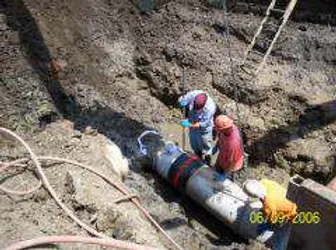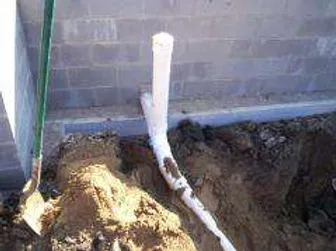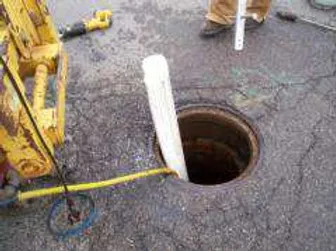Our Government
Skip to content




Waste Water Information
Sewer Maintenance
SEWER BACKUPS
Sewage moves from the pipes inside your home or business to the City’s Wastewater Plant for treatment. If the line becomes clogged or full, it can cause the pipes to backup.
Who to Call
If a backup occurs, please call the City of London Wastewater Department during normal business hours (7:30 a.m. to 4:00 p.m., Monday – Friday) at 740-852-0279. If no one is available to take your call, please call the City’s Police Dispatch at 740-852-1414.
Determining the Problem
Upon receipt of a backup call, the Wastewater Department personnel will respond to check the public sewer system. If problem is located in the City system, the City will address the problem. If the problem is located in your sewer line, you will be advised to hire a plumber to inspect the line and remove any obstructions.
Insurance
The majority of backups are the result of problems in the customer’s sanitary system. In these instances, the customer is responsible for all costs. It should be noted that many insurance policies do not cover sewer backups unless special coverage is purchased. The City strongly encourages all sewer customers to review their policy to determine whether they have this coverage. If a sewer backup could impact finished living space, a business or cause other hardships, you may wish to consider purchasing the additional coverage.
The City conducts routine cleaning and inspection of the sanitary sewer system to assure its proper operation. However, backups in the City mains may occur as a result of situations beyond our control -- such as the introduction of inappropriate materials into the main, i.e., grease poured into a drain, diapers flushed down a toilet, sticks pushed into manholes, heavy rains or tree roots entering the line. In such cases, the City is not held responsible for damage caused by a backup unless negligence by the City can be determined.
Clean Up
The City does not assist with cleanup of private property resulting from problems in the sewer system. If the cleanup is major, there are companies that can assist. If you have sewer backup coverage, you should coordinate any contracted cleaning service with your insurance company.
Prevention
Preventative measures can help reduce or minimize the potential for a backup. Following are some suggested guidelines:
Freeze the Grease, Save the Drain
One of the biggest culprits of lateral blockages is grease and oil from cooking. Rather than pouring grease or oil down the drain, put it in a disposable container (such as an empty milk carton or food can). To make it easier to dispose of, put it in the freezer until is it set and then throw into the trash can.
Avoid Drain Pain
Some things just aren’t meant to be flushed down the toilet! For example, not all paper products are created equal. Toilet paper is designed to flush and break down in the sanitary sewer system. Paper towels, tissues, diapers, diaper wipes, cleaning wipes and feminine products are not. Some other items to avoid:
Rags and towels
Cotton swabs
Cotton balls
Syringes
Food wrappers
Sponges
Aquarium gravel
Kitty litter
Cigarette butts
Dental floss
Hair
Disposable toilet brushes
Items like these can clog or damage your sewer system resulting in a backup. So remember, when in doubt -- throw it out. The toilet is not a trash can!
Know Where Your Clean out Is
Current code requires that every new sewer lateral installation include a sanitary sewer cleanout. This portal to your system makes it easier to inspect and clean the line. Do not cover it with dirt or other landscaping materials so it may be found quickly. Check the cap routinely to assure that it is in place and in one piece, as a broken or missing top can allow the entrance of rainwater, increasing your risk of a backup during heavy storm events. If you have an older home without a cleanout, you may wish to consider installing one.
Choose and Plant Trees Carefully
Don’t plant trees or shrubs above or near your sewer lateral to prevent their roots from entering the line through cracks and joints. Avoid placing species that have more aggressive roots systems such as birch, willow, poplar, ash, and elm in the part of the yard where your sewer line is located.
Maintain Your Line
Before buying a house, it is recommended that a sewer line inspection be conducted. For best results, the contractor conducting the inspection should use a lateral inspection camera and provide you with a copy of the results. Do not overlook any problem in the sewer lines. Slow draining sewers may be the first indication of a bigger problem.
Remove Storm Drain Connections
If you have storm drain connections that convey water from roofs, foundations, sump pumps, yards or other areas into your sewer lateral, they should be removed. These are actually illegal connections and subject your home to a higher potential for backup during rain events. These types of fixtures should be connected to the storm sewer system (for more information on how to connect to the storm sewer system, contact the City’s Street Department at 740-852-1404)
Consider Installation of a Backwater Valve
Homeowners who have experienced frequent backups may wish to consider installation of a backwater valve. This valve is a fixture installed on a sewer line, and sometimes a drain line, in the basement of your home or building foundation to prevent sewer backups. A properly installed backwater valve works on a one-way system; sewage can go out, but not back in. Once installed, these become part of your private system and should be maintained in accordance to the manufacturer/installer instructions.
Review Your Insurance
Most general homeowner’s insurance policies do not cover sewer backups. It is suggested that you review your policy and if yours lacks this coverage, you may wish to consult with your insurance agent as to whether it might be of benefit to add this coverage.
My sewer is backing up, who is responsible?
It is always best to have the Wastewater Department check the main. If it is running smoothly, the problem is generally in your sewer lateral. The city is responsible for the sewer main only. The property owner is responsible for the line from the main to the home as well as all interior plumbing.
What is a sewer clean out and where is mine located?
A sewer clean out is a point of access to your sewer lateral that allows for cleaning and maintenance. It is usually 4-inches in diameter and has a plastic or metal cover over it. The clean out is the responsibility of the property owner and the City does not have locations on file for most clean outs. The clean out is frequently located in the yard near where your sewer lateral enters the home. If you have an older home and do not have a clean out, you might wish to consider having one installed by a plumber to make cleaning and emergency responses easier.
What can I do to prevent sewer backups?
The most common causes of sewer backups are clogs or roots in the sewer lateral. To prevent clogs, don't flush large items such as diapers or sanitary napkins. Dispose of grease in a trash receptacle rather than down the drain. Don't plant trees near sewer lines as their roots may find their way into your lateral. Some trees which are especially troublesome: willows, poplar and cottonwood. Do not direct water from storm drains or sump pumps into your sewer lateral. Not only is this a violation of city ordinance, but it can also overwhelm your system and result in backup.
What do I do if I see someone putting trash or other items into a manhole or catch basin?
Manholes provide access for maintenance to our storm and sanitary sewers. Catch basins provide collection points for storm water during rain events. Putting trash, leaves, car oil, etc. in them can impede the ability of these systems to perform their intended duty. The result can be a sewer backup impacting nearby homes or flooding during a storm. If you see someone dumping into these systems, please contact the Wastewater Department at 740-852-0279.
Who do I call if I have a sewer backup or other sewer maintenance question?
These calls should be directed to the Wastewater Department at 740-852-0279. If you experience a sewer emergency after 4:00 pm or on the weekends, call the police dispatcher at 740-852-1111, and they will contact the on-call personnel.
Sewer Extensions
To extend the sewer line in the City of London, the developer of the property must follow the city’s sewer usage ordinances and be designed by an engineer and drawn with the specification and plans submitted to the City for review, then submitted to OEPA. The construction of the sewer extensions is inspected by the Wastewater Department to ensure they are built to the City’s specifications.
Lateral Connection
For a property owner to connect to the City’s sewer, they must obtain a tap-in permit from the City’s water department. They must pay a tap fee, capacity fees and an application fee. After paying the fees, they are issued a tap-in permit. When constructing the lateral, the contractor must follow the sewer usage ordinances listing the general regulations and specification for the construction of the sewer extensions. The lateral connection is inspected by the Wastewater Department to ensure it meets the City’s specifications before the line can be buried. Any time a lateral is dug-up, repaired or replaced, the property owner must call the Wastewater Department for an inspection at 740-852-0279. Please provide 24 hours notice for inspection.
Definitions:
Sewer Lateral – The sewer lateral is a private line that takes the sewage from the building to the City’s sewer main. The responsibility for maintenance of this line from the property to the City’s main lies with the property owner and/or resident.
Sewer Main – These are the large pipes that collect the sewage from the laterals and convey it to the Wastewater Plant. They are maintained by the Wastewater Department.


Left: New Oak Run trunk sewer line installed in 2006.
Right: Sewer project reline on Fifth Street.
Left: House Lateral with clean out being installed
Right: New sewer line installation on Chandler Avenue.


